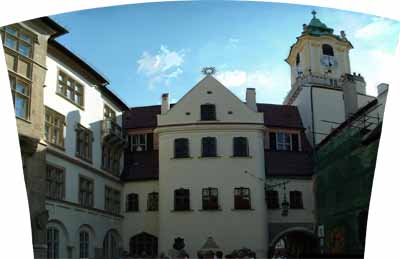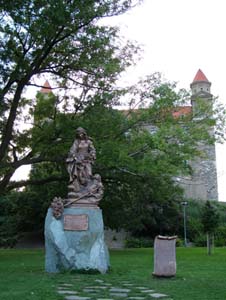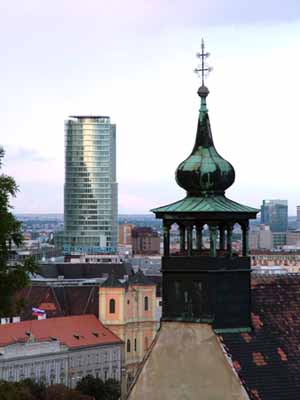
|
VENUE & HISTORY OF BRATISLAVA |
Bratislava is located in mild climate zone of continental nature, which is characterised by distinct differences between temperatures in summer and in winter as well as by 4 seasons of the year taking turns. Within the past years, however, transition of winter to summer is almost without the spring transition in Bratislava. The same applies to transition of summer to winter, which happens quickly, whereas autumn is usually little distinctive and short. The typical temperatures recorded at the beginning of September are around 20-25 °C. Bratislava, the capital city of Slovakia ranks among the youngest capital cities of Europe and, at the same time, among the towns with rich history dating back to the times of more than two thousand years ago. |
|
First traces of permanent settlement are related to the later Stone Age. However, real door to history are opened only by the Celtic tribe of Boyds in the 2nd century BC, who established a significant power centre in the territory of the town with defence function, which earned fame also thanks to minting coins of which staters are best known with the sign Biatec. So, Bratislava similarly to Vienna, Budapest, Paris or other European meptropoles, is standing on foundations of Celtic settlement. |
|
Bratislava and Romans. At the time when Christ was born, Romans discovered strategic significance of the area of present Bratislava. They did not occupy this territory for good. They just built here military quarters being strategic from perspective of trade, too. One of the quarters was Gerulata in the territory of present village of Rusovce, which was integral part of the defence system Limes Romanus separating the world of Romans from that of barbarian tribes. Bratislava thanks to Romans also for its fame of a town of vintners and wine-growers. During offensives, Roman legions were extending, upon command by sovereign, growing of vine and production of wine in all occupied territories. This way wine-growing got to France, Spain, Germany as well as to the territory of Bratislava and its surroundings. |
| Greater Moravian Empire. During migration of nations, Slavs settled in the territory of present-day Bratislava. Under leadership of Frankish merchant Samo; the Samo‘s Empire was established – the first known tribal union of Slavs. It was preceded by raids of fighting tribes of nomadic Avarians and necessity of defence against them. After Samo‘s death, Samo‘s Empire disintegrated into principalities. By subsequent joining the principalities, a state formation of Greater Moravia was founded. Fame of the empire reached its peak in the reign of the most significant sovereign Svatopluk. The beginning of its gradual cessation is associated to the first written reference to the castle of Bratislava in annals of Salzburg of 907, when a battle took place near the castle between Hungarian suites and Bavarian army. Old Hungarians won it, subsequently occupying eastern part of Greater Moravia. |

|
Medieval Bratislava. In the end of the 10th century, the Hungarian state was established, while the territory of present-day Bratislava was annexed to it in the reign of Stephen I (1001-1038). Bratislava became an important economic and administration centre of Hungarian borderland. Besides advantages following from this position, significance of the castle of Bratislava and its vicinity was also bringing negatives in the form of frequent military attacks. As early as in 1042, German King Henry I destroyed Bratislava. Further unrests hit it between 1074 - 1077 in relation to a dispute regarding Hungarian throne. In the 13th century, royal privileges were granted to Bratislava. Significant period in life of the town at the turn of the 14th and 15th centuries was that of reign of Sigismund of Luxembourg. Sigismund confirmed earlier donations and privileges |
| to the town granted by the ruling families of Arpads and Anjouos and, granting new privileges, he accentuated Bratislava as a prominent political and economic town of Hungary. Based on his decree of 1405, Bratislava ranked among the most significant towns that had been called royal towns since then. In 1434, he granted the town a heraldic deed with the right to use a coat of arms with three towers above an open gate in city walls. In 1465, King Mathias founded the first university in the territory of present Slovakia – Academia Istropolitana; |
| Bratislava was the Coronation City of Hungarian kings. Unexpected turn in the history of the town was brought by the 16th century. In a tragic battle with Turks at Mohac in 1526, the Hungarian King Louis II perished. Ferdinand of Hapsburg was elected new king at a session in the Franciscan church in Bratislava, despite his rival candidate Jan Zapolsky and despite resistance of part of Hungarian nobility. Turks were advancing very fast into the country. Hungarian nobility protected themselves by flight to the present territory of Slovakia, where state offices were moving, too. In 1530, Turks jeopardised also Bratislava, partially damaging it by shellfire. Disaster that afflicted Hungary after the battle at Mohac was paradoxically positive for Bratislava. After the capital city Buda was occupied, Hungarian nobility, secular as well as church dignitaries were looking for their refuge north of the Danube and as close as possible to where the King Ferdinand was residing. Convenient position and relative safety of Bratislava decided that it became capital city of Hungary. It was decided by the Hungarian assembly at its session in 1536. The town of merchants, craftsmen and wine-growers became residential town of the country, seat of nobility and church. |  |
|
|
Bratislava became an assembly town of the Kingdom and a coronation town of Hungarian kings, residence of king, archbishop as well as that of the most significant institutions of the country. Within 1536 – 1830, there were crowned 11 kings and queens in the Dome of St. Martin. <-Bishop's Pallace |
| Bratislava – town of Maria-Theresa. (Coronation in 1741). In the 18th century, Bratislava became not only the largest and the most significant town of Slovakia but that of entire Hungary. In that century, many pretentious palaces of Hungarian aristocracy had been built, there had been constructed churches, monasteries and other church buildings, the castle was reconstructed and extended, there were growing new streets, while the number of population tripled. Sessions of the assembly of estates took place there as well as coronations of kings and queens, while the town was vibrant with nimble cultural and social life. The period of highest upswing of the town is represented by the time of reign of Maria-Theresa (1740 - 1780). Since her accession to the throne, construction office of the Hungarian Royal Chamber started directing construction development in the town, controlling especially construction of public buildings (palace of Hungarian Royal Chamber, Water barracks and others). Large construction arrangements were also made in the castle that became a representative royal seat (not that of its Hungarian vice-regent) and a centre of social and political life of top level. The reign of Joseph II meant for Bratislava a fall from glory. Bratislava ceased to be capital city of Hungary. Upon Joseph‘s order, the Vice-regent Council and other central offices were moved to Buda in 1783 and, on May 13, the royal crown guarded at the castle of Bratislava till then. Moving central offices called up mass departure of nobility from the town. Bratislava changed from capital of the country back to a provincial town. |
|
|
| Bratislava – between campaigns of Napoleonic troops and abolition of serfdom. The beginning of the 19th century was borne in the sign of Napoleonic wars. After the battle at Austerlitz in 1805, the so-called Peace of Pressburg was concluded between France and Austria in the Mirror hall of the Primacial palace. Nevertheless, the peace did not last for long and, as soon as in 1809, the Napoleon‘s army damaged the town by shellfire from the right bank of the Danube. Since 1830-ies, rapid upswing of industry began in the town, supported by introduction of state-of-the-art transportation. To a great extent, fast transport was enabled on the Danube by steamboats capable of sailing also upstreams. Steam trains started running since 1848. The last big political event in the town of Hungarian times was a session of the Hungarian assembly of estates within 1847-1848. In March 1848, the assembly voted for abolition of serfdom. Emperor Ferdinand V subsequently visited Bratislava, signing and declaring the so-called Acts of March in the Mirror hall of the Primacial palace on 11 April 1848. After dissolution of the last Hungarian assembly and moving political seat of Hungary to Pest, Bratislava definitely becomes politically less significant. |
| First Czechoslovak Republic. Important milestone in the history of the town was the World War I. Bratislava was not hit by fights directly, but population was bearing consequences on everyday basis. Supplies were failing, prices were highest in the whole monarchy. The end of the World War I in November 1918 brought about changes on the map of Europe. Austro-Hungary disintegrated, while the Czechoslovak Republic was established. Fate of Bratislava was decided at Paris peace negotiations. When it was already obvious by the end of 1918 that Bratislava would be included to the Czechoslovak Republic, representatives of the town decided to rename it to Wilsonov or Wilsonovo city after the US President T.W. Wilson. Representatives of the town required powers of the treaty to acknowledge it as open – free town. However, this proposal was turned down and the town called Pressburg, Pozsony, Prespork was affiliated to the Czechoslovak Republic in January 1919. A new designation was approved on 27 March 1919. Bratislava appeared on the map of Europe. |
| Bratislava in the interwar period, was developing in a relatively harmonious way. At that time, the town recorded urban, architectural, industrial and production upswing. There were living several ethnic and cultural communities - |
|
| Slovak, German, Hungarian, Jewish, Czech, Croat – in exemplary tolerance as long as till the time of the World War II. |
|
Wartime Bratislava. Growing influence of Hitler in Central Europe reached its peak in March 1939 by disintegration of Czechoslovakia. Protectorate under Nazi administration was established in the Czech territory. Slovak politicians were called on by Hitler to decide on further fate of Slovakia. Out of two alternatives– division of Slovakia among Poland, Hungary and Protectorate of Czechia and Moravia or establishment of an independent state, the then political leadership made up their minds for the second alternative. Thus the independent Slovak State was established, whose 6-year existence remains a controversial chapter of the history unresolved till the present day. During existence of the Slovak State, Bratislava became capital for the first time. The town was a seat of President, Parliament, Government and all offices of state administration. However, it lost part of its territory - Petrzalka and Devin were annexed to Germany. By the end of the war, Bratislava, as a capital city of an allied country of Hitlerian Germany, was bombed by the US Air Force. On 4 April 1945, Bratislava was liberated by the Stalin‘s army. |
| Post-war Bratislava. After the World War II, the situation in Bratislava was fundamentally changed. Most of its Jewish population had not returned from concentration camps, while a majority of German and Hungarian ethnicities were also removed from the town after liberation. This way Bratislava lost its unique multi-cultural atmosphere. Communist coup in February 1948 meant a break in post-war development of Czechoslovakia. Czechoslovakia became constituent part of the socialist camp and a buffer zone between the West and East. Europe was divided by iron curtain. For Bratislava, which was after the war still connected with Vienna by tram, it meant building closed borders with the West. As well parts of the town got to the boundary zone separated with barbed wire. Its citizens had to be ousted. The end of 1940-ies and the beginning of 1950-ies were borne in the sign of reconstruction and repeated construction of city parts destroyed by the war, especially of industrial plants that were nationalised after 1948. Communist retaliation intervened into lives of citizens in 1950-ies. Many people were arrested, while thousands of citizens accused in trumped-up trials were forcibly ousted from the town. More than 40-year period of persistence of the communist regime was interrupted by events of 1968 – 1969. Their symbol became Alexander Dubcek. Democratic changes commenced were suppressed only by occupation by the armies of the Warszaw Pact. Subsequent „temporary stay“ of the Soviet troops lasted for more than 20 years. Together with extensive political persecutions, it should be a safeguard against possible attempts for reforms, for possible change of social order in Czechoslovakia. |  |
|
Bratislava – capital for the second time. Events of November of 1989 in Prague launched dismantling of communist regime. At the same time, for long time unresolved question of real federalisation of Czechoslovakia was raised along with first political changes. Inability of political elites of that time to find a compromise resulted in disintegration of Czechoslovakia. At the stroke of midnight from 31 December 1992 to 1 January 1993, Czechoslovakia ceased to exist for the second time. Bratislava became again capital city of independent Slovakia. Status of capital meant radical changes in nature of the town. In the beginning of 1990-ies, visitors of Bratislava were expressing themselves as a town where war just ended up. Nowadays, it is considered one of the most dynamically developing and the most prospective regions of Europe. |